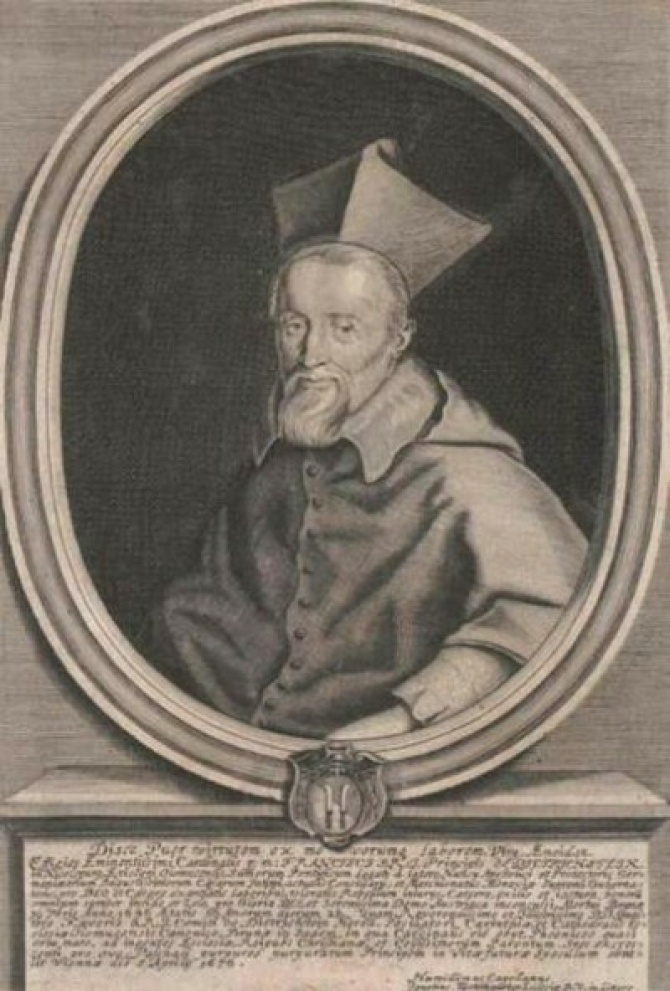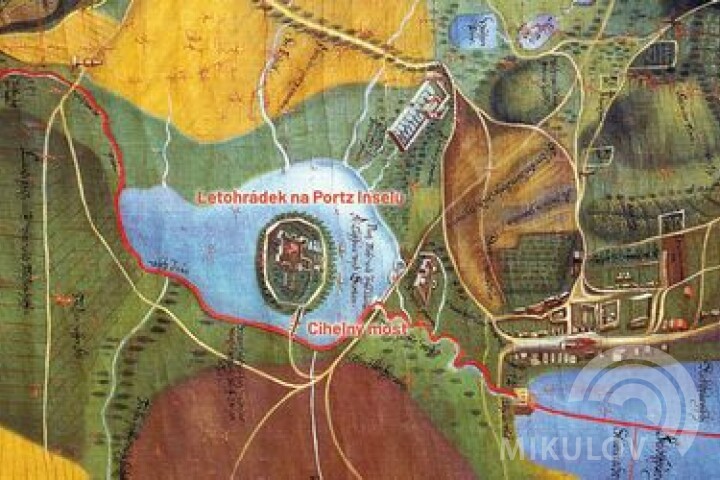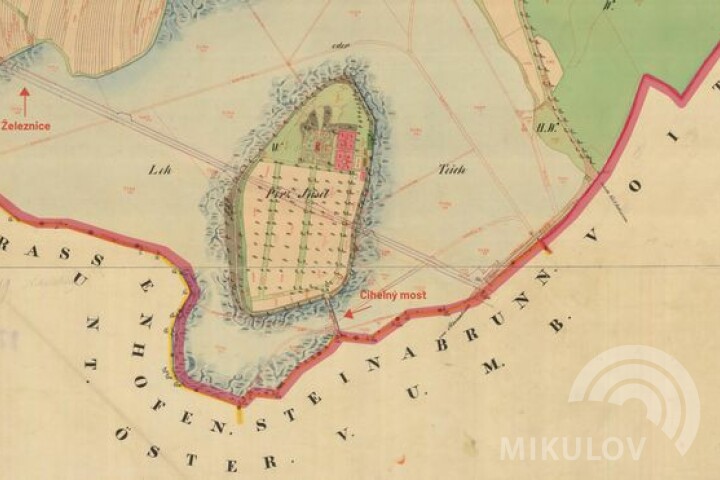In the era of the late Renaissance and early Baroque, the cultural landscape around Mikulov was the scene of extraordinary activities. Artificial ponds and small streams to the south and east of the residential town were interconnected into a magnificent landscape system, the unifying element of which was water. The pond cascades, stream and millrace beds, water mills and fisheries, avenues of trees and orchards, bridges and summer houses all created an almost magical landscape.
In the first half of the 17th century there was a summer residence built on an island in Portz pond (today New pond) and complemented by flower arrangements and a forest park. The island complex, accessible over the long brick bridge and connected with the City of Mikulov through a two and a half kilometre long allée, was an extraordinary work of architecture of its time. In the late 19th century it was still described by historians as a landscape jewel of unique beauty. The complex was surrounded by gardens and cultivated vegetation, providing a place for enjoyment, respite, and also to display the status of the Mikulov Princes of Dietrichstein.
Today’s peninsula, where the above mentioned complex is located, used to be an island named after Portz pond (or the Quiet Island). The body of water then surrounding the pond was approximately twice as large as compared to its area today. The summer residence, referred to as “Lusthaus” in the land register from 1629, was protected with bastions, and the opposite buildings used as dwelling and service spaces, were originally connected with the summer residence through an underground corridor. This “paradise” island was connected to land with a complex bridge construction made up of many brick arches which was almost forgotten until recently. The extensive complex enclosed by a wall with corner bastions and its buildings were drawn during the first military mapping from 1764 to 1768, also capturing the fish holding cages and fishery at the edge of the pond.
The golden era of the summer residence complex suddenly came to an end in 1872 when, in consequence of building a railway line to Mikulov, the pond was drained and the bridge lost its main function. It continued to serve as the crossing over the Rybniční brook. The pond was later restored in the northern surroundings of the island, though due to the railway line it could not be refilled in its original scope, its southern part changed into a wetland forest and meadow. The island became a peninsula and the essentially disused bridge was no longer maintained. Thanks only to the inimitable quality of the bricks made by Mikulov’s skilful brickmakers of the 17th century, the construction has survived until today. As the whole area had been tightly enclosed over the period of 40 years under the totalitarian regime, the bridge was in a state of disrepair when the restoration carried out from 2019 to 2020 saved it for the future.
In the mid-20th century the pond was partially renovated in its northern part (today the Nový pond). The island would be maintained until the beginning of World War II, as confirmed by a record from 1937 (Haimatbuch Nikolsburg) about a rare visit from Windsor Castle. It was not the first time the Dietrichsteins received distinguished European monarchs on the island, but it was the last time In 1938 only the site administrator would stay on the island and after 1945 the whole area became part of the guarded border zone. In 1995, after the area was made accessible again, the summer residence complex was listed as cultural heritage site. The gradual renovation of the summer residence began in 2003 and still continues. Now the summer residence is in private ownership.

The supposed founder of the complex was Franz Cardinal Dietrichstein, who did so after taking over the Mikulov family estate following his brother Maxmilian’s death in 1611. A preserved copy of the Mikulov estate land register from 1629 mentions Portz in more than one place. The previous land registers do not know any manor on Portz. According to the 1629 land register, by the first third of the 17th century the island estate included a summer house (Lusthaus), an ornamental garden or a “paradise of pleasure” (Lustgarten) with art objects arranged within it, a fruit and kitchen garden and an ice cellar (Eisgrube). The land register from 1655, made out after the death of Franz’ nephew, Maxmilian II of Dietrichstein, recorded that “there are more parks on Portz planted with flowers and various trees, and also a mansion called Lusthaus, with gardens situated in front of it“.
Franz Cardinal Dietrichstein is a widely known figure of central European history in the early modern times. He would purposefully bring to Moravia the period concepts of Italian Recatholization culture that he was intimately familiar with. As a clergyman, the Prince initiated the building of several works of religious architecture in Mikulov, inter alia Loreta and the Way of the Cross on the Sacred Mound. The walled summer residence complex, complemented by other buildings and majestic gardens, was to display the grandeur and majesty of its builder, the Prince, moving in the circles of high clerical and secular dignitaries of the Catholic world.
Ruins of a outbuilding
Near the eastern shore of the island was an outbuilding whose appearance in the 17th century is possible to only reconstruct hypothetically, since only its torso has been preserved. A map of the island from 1785 includes a building of a very narrow oblong plan which corresponds to the length of the side of the opposite bastion plateau. At present there are only ruins of a storey building left, in the southern direction being adjoined by an outer wall of the ground-level farm building. It was set in the defensive wall surrounding the island, with further outbuildings added to it later. The remnants of the storey building masonry still bear traces of the sgrafitto or plaster trimming, and some remarkable elements are visible, in particular walled-in window openings on the ground level of the eastern facade, facing the lake water.
Historical plan
Historical plan of possible alterations on the island until the beginning of the 19th century. The island was used by the nobility to pursue their leisure interests and amusement, as recorded in the Mikulov estate’s land register as early as 1629. Here the summer residence on the island is described and in particular the pleasure garden around it. The Portz summer residence saw an important event in July 1672, then with the bridge definitely being completed. Within the preparations for a visit by the Emperor Leopold I, Prince Dietrichstein writes in his instruction to the Mikulov governor to “put fine gravel from the quarry on the bridge to the Island (but no big pieces)”. Source: Moravian Provincial Archive, Brno, collection F18, the Main Filing Cabinets of the Dietrichsteins in Mikulov, Historical plan of possible alterations on the island until the beginning of the 19th century, undated, map 146. Modified.
From the 17th century onward, the border between the Czech Lands and Austria running through the area of Portz Insel was frequently changed.
This border was also a boundary always dividing the estate of Mikulov and that of Steinebrunn in Austria. However after Franz Cardinal Dietrichstein became the only holder of the two estates, the political and land dividing boundary was reduced to only theoretical importance, though relevant symbolically. In this way the ambition of the Dietrichstein family came to fruition.

A bird‘s-eye view map of the Mikulov estate drawn up in 1672 by Clemens Beuttler of Ebelberg for the Prince Ferdinand of Dietrichstein. The cutout of the preserved fragment captures the Moravian-Austrian borderline in the 17th century. Source: A map of the Mikulov estate from 1672, a collection of the Regional Museum, Mikulov, inv. no. 4872. Modified.

A cutout of the stable cadastre map from 1826. A new railway line under development (1872) was later entered into this older map. The original pond was already drained then (1855–1857). Source: Imperial obligatory imprints of stable cadastre – Moravia and Silesia. Archival documents from the Central Surveying Archives and Cadastre, www.cuzk.cz. Modified.














